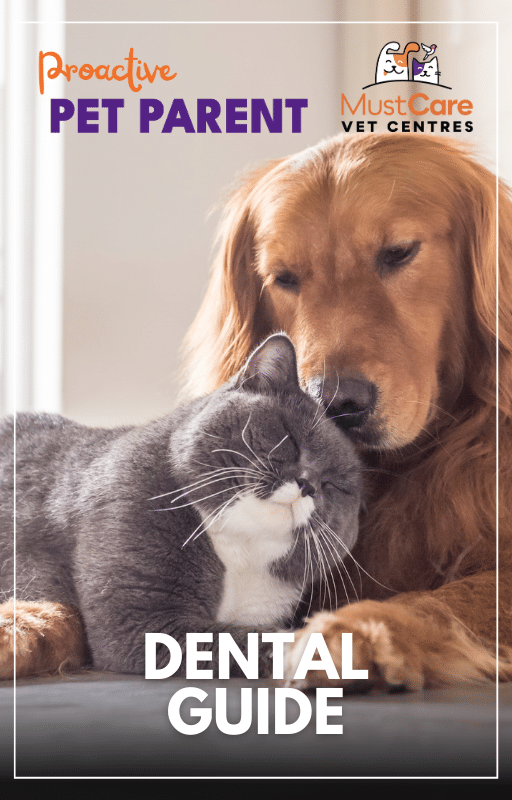Share This Blog With Other Pet Parents!
Managing Dog Ownership Costs: Your Guide to Annual Expenses
Are you considering adding a furry friend to your family? While the joy of dog ownership is undeniable, it’s essential to understand the financial commitment involved. From vet bills to food and grooming expenses, the costs can quickly add up.
In this article, we’ll delve into the often-overlooked aspect of dog ownership: the annual expenses. We’ll explore the key factors contributing to the cost of owning a dog, including veterinary care, supplies, and unexpected emergencies. We’ll also uncover smart strategies for budgeting and preventative care that can help you save money in the long run.
What you’ll learn from this blog:

For all you need to know, download our
FREE Dental Guide

This blog is part of our Proactive Pet Parent series! This is just the beginning… To see more blogs, click here! Better yet, sign-up to our newsletter to receive these directly to your inbox each month.
Sign-up To The Proactive Pet Parent Newsletter
Understanding Annual Expenses
Understanding the true cost of dog ownership goes beyond the initial adoption or purchase fees. It encompasses a wide range of expenses that accumulate over the course of your canine companion’s life. These are some of the annual expenses to factor in:
- Routine veterinary visits are a primary consideration, encompassing annual check-ups, vaccinations, and preventive medications such as flea and tick prevention. The cost of these visits can vary depending on your location, the size and breed of your dog, and any specific health concerns they may have.
- The recurring costs of essential supplies, including food, treats, and grooming products. Investing in high-quality nutrition is crucial for your dog’s health and well-being, but it can come with a higher price tag.
- Grooming expenses also factor into the equation, whether you choose to groom your dog at home or enlist the help of a professional groomer.
- Other annual expenses to consider include pet insurance premiums, which can provide peace of mind in case of unexpected medical emergencies, and licensing fees required by your local municipality.
By understanding the breakdown of these annual expenses, you can create a realistic budget that allows you to provide the necessary care for your furry friend while managing your finances effectively.
The Benefits of Preventative Care
Investing in preventative care for your dog can yield numerous benefits, both for their health and your wallet. Regular check-ups with your veterinarian allow for early detection and treatment of potential health issues, preventing more significant problems down the line.
Vaccinations and parasite prevention medications protect your dog from common diseases and infestations, reducing the likelihood of costly veterinary interventions.
Additionally, routine dental care, such as regular teeth cleanings and dental exams, can prevent dental disease and its associated expenses, such as tooth extractions and treatment for gum disease.
Prioritising preventative care is a smart investment in your dog’s well-being and your financial stability, ensuring that you can enjoy many happy and healthy years together without breaking the bank.
Smart Strategies for Budgeting
When it comes to budgeting for your dog’s expenses, there are several smart strategies you can employ to keep costs manageable without sacrificing quality care. These include:
- Establishing a dedicated pet fund where you can set aside a portion of your monthly budget specifically for your dog’s needs. This fund can help cover routine expenses such as vet visits, vaccinations, and grooming appointments, as well as unexpected emergencies.
- Researching affordable veterinary clinics in your area and comparing prices for routine services can also help you save money without compromising on quality.
- Consider taking advantage of discounts and promotions offered by pet supply stores or online retailers when purchasing food, treats, and other essentials.
- Another budget-friendly option is to explore DIY grooming techniques and basic training exercises that you can do at home, reducing the need for professional services.
By implementing these smart budgeting strategies, you can ensure that your dog receives the care they need while staying within your financial means, giving you peace of mind and financial stability as a responsible pet owner.
Investing in Quality Nutrition
One of the most important investments you can make in your dog’s health is providing them with a balanced and nutritious diet. While it may be tempting to opt for cheaper, lower-quality dog food options to save money, investing in quality nutrition is essential for your dog’s overall well-being and long-term health.
High-quality dog food is formulated to meet your dog’s specific nutritional needs, providing them with the essential vitamins, minerals, and nutrients they need to thrive. Additionally, a balanced diet can help prevent common health issues such as obesity, digestive problems, and allergies, reducing the likelihood of costly veterinary visits and treatments.
When choosing a dog food, look for options that list real meat as the first ingredient and avoid artificial preservatives, colours, and fillers. By investing in quality nutrition for your dog, you can ensure that they live a happy, healthy, and active life, saving you money on veterinary expenses in the long run.
DIY Grooming and Basic Training
Taking a hands-on approach to grooming and basic training can not only strengthen the bond between you and your dog but also save you money on professional services.
With the right tools and techniques, you can tackle grooming tasks such as brushing, bathing, and nail trimming at home, reducing the need for frequent trips to the groomer. There are plenty of online resources and tutorials available to help you master these skills, allowing you to keep your dog looking and feeling their best without breaking the bank.
Similarly, basic training exercises such as sit, stay, and come can be taught at home with consistency and patience. Investing time and effort into training your dog yourself not only saves money on obedience classes but also allows you to tailor the training to your dog’s specific needs and personality.
By incorporating DIY grooming and basic training into your routine, you can take control of your dog’s care and build a stronger, more rewarding relationship with them in the process.
In conclusion, navigating the financial aspects of dog ownership requires careful planning, but with the right strategies, you can provide your furry friend with the best care while staying within your budget. We’ve explored the various expenses associated with owning a dog, from veterinary care and grooming to food and supplies.
By understanding the true cost of dog ownership and implementing preventative care measures, you can save money in the long run while ensuring your dog’s health and well-being. Budgeting for your dog’s expenses is an ongoing process, and it’s essential to regularly review your finances and adjust your budget as needed. Whether you’re a seasoned pet owner or considering bringing a dog into your family for the first time, taking a proactive approach to financial planning can help you provide the best life possible for your canine companion.
As always if you have any questions for the veterinary team at MustCare, please get in touch today.

